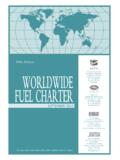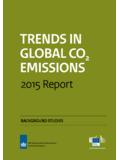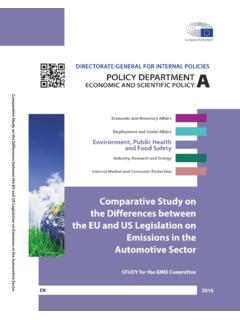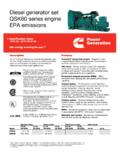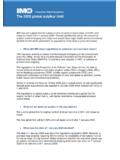Transcription of A technical summary of Euro 6/VI vehicle emission …
1 BRIEFING. JUNE 2016. A technical summary of Euro 6/VI. vehicle emission standards This briefing is a comprehensive technical overview of the Euro 6/VI vehicle emissions standards , which tighten limits on air pollutant emissions set in previous European standards and require the best technology currently available for vehicle emissions control. Countries outside of Europe, the United States and Japan have largely patterned their emissions policies on European regulations and the associated mandates for clean, low-sulfur fuels. By adopting the Euro 6/VI vehicle emission standards , these countries can achieve up to a 99 percent reduction in the emission of pollutants like fine particulate matter ( ), reducing the risk of ischemic heart disease, lung cancer, stroke, and asthma.
2 In this briefing, we look at the historical context of European regulations, summarize the core technical elements, review the control strategies available to achieve the pollutant limits, and conclude by considering what is likely to come next in the European regulatory pathway. BACKGROUND. The G-20 countries account for 90 percent of global vehicle sales, and 17 out of the 20. members have chosen to follow the European regulatory pathway for vehicle emissions control. The European pathway consists of six stages of increasingly stringent emission control requirements, starting with Euro 1/I in 1992, and progressing through to Euro 6/.
3 Prepared by Martin Williams and Ray Minjares. BEIJING | BERLIN | BRUSSELS | SAN FRANCISCO | WA S H I N G T O N. ICCT BRIEFING. VI in A number of Asian and Latin American countries currently have Euro 2/II, 3/III, and 4/IV standards in force. The European Commission's Thematic Strategy on Air Pollution, adopted in 2005, sought to reduce transportation emissions as part of an overall air-quality- improvement strategy. The Euro 6/VI emission standards specifically noted that a considerable reduction in NOX [oxides of nitrogen] emissions from diesel vehicles is necessary to improve air quality and comply with limit values for air pollution.
4 2. It was clear in 2005 that member states would face difficulties achieving ambient NO2 limit values by 2010, and that adoption of Euro 6/VI emission standards would be a determining factor. The proposal further noted that meeting the NOX emission standards requires reaching ambitious limit values at the Euro 6 stage without foregoing the advantages of diesel engines in terms of fuel consumption and emissions of hydrocarbons and carbon monoxide. 3 The Commission recognized that setting more ambitious emission standards for NOX at an early stage would provide long- term planning security for vehicle manufacturers who wish to continue pursuing diesel technology.
5 Euro VI limits for heavy-duty vehicles were introduced in Regulation 595/2009, and were amended by Regulations 582/2011 and 133/2014. The Euro 6 limits for light-duty vehicles came earlier and were introduced along with Euro 5 limits under Regulation 715/2007, promulgated in 2007. The simultaneous release of the Euro 5 and 6 light-duty vehicle standards provided the automotive industry with a longer timeline to develop strategies for meeting future emission limits. Other countries following the European pathway can move directly to Euro 6 for light-duty vehicles and Euro VI for heavy-duty vehicles now that the technology is available to meet the emission standards .
6 A fundamental prerequisite for the efficient operation of exhaust aftertreatment devices for both light- and heavy-duty vehicles is having fuel with a very low sulfur content. The sulfur content of gasoline and diesel fuels in Europe has therefore been regulated to meet very stringent fuel-quality standards . Prior to the Euro 3 and 4. standards , regulations required a minimum diesel cetane number of 51, beginning in 2000, and a maximum diesel sulfur content that year of 350 ppm. Starting in 2005, the maximum diesel sulfur content was limited to 50 ppm. Gasoline sulfur content was regulated to 150 ppm in 2000, and 50 ppm in 2005.
7 By 2005, Europe began the phase-in of virtually sulfur-free gasoline and diesel fuels (<10 ppm sulfur), replacing 50ppm fuels, which were ultimately phased out by 2009. Without these fuel-quality improvements, the increasing stringency of the limits in European standards would not have been possible. 1 The European standards are designated by Arabic numerals for light-duty vehicles, and Roman numerals for heavy-duty vehicles. 2 Regulation (EC) No. 715/2007 of the European Parliament and of the Council, Official Journal of the European Union, L 171/1, June 29, 2007, :L:2007:171:0001:0016: EN:PDF. 3 Regulation (EC) No. 715/2007 of the European Parliament and of the Council, Official Journal of the European Union, L 171/1, June 29, 2007, :L:2007:171:0001:0016: EN:PDF.
8 2. A technical summary OF EURO 6/VI vehicle emission standards . Defeat devices that reduce the effectiveness of emission controls, along with irrational control strategies,4 were prohibited in Directive 2001/27/EC for diesel vehicles. Additionally, durability and on-board diagnostic (OBD) requirements were introduced for Euro IV and V in Directive 2005/55/EC, and the technical requirements were specified in Directive 2005/78/EC. Directive 2005/55/EC also restated the emission limits for Euro IV and V with additional language on the verification of European Transient Cycle (ETC) tests. A full history of the European emission and fuel- quality standards is available at: THE EURO 6 standards FOR LIGHT-DUTY VEHICLES.
9 emission LIMIT VALUES. European emission standards regulate gasoline and diesel vehicles separately. Considering first the standards for diesel vehicles (see Table 1), Euro 6 is a significant advancement over Euro 5 with regard to NOX limits. The NOX limit declines from g/ km to g/km, a reduction of 56%. Explicit NOX limits were introduced at the Euro 3 level, and in the Euro 6 standards the NOX limit is 84% lower than the Euro 3 level. This has significant implications for control technologies, requiring for the first time the integration of emission control aftertreatment for NOX emissions , such as selective catalytic reduction, lean NOX traps, or others.
10 The particle mass and particle number standards for diesel cars in Euro 6 are the same as those in Euro 5. Limits on particle mass emissions for diesel cars have nonetheless been reduced by large amounts since the Euro 1 standards were introduced. The Euro 6 particle mass limits for diesel cars represent a reduction of 96% from Euro 1 limits. The particle mass limits are now so low that measurement accuracy and sensitivity are an issue, which has prompted the introduction of limits on particle number, which is easier to measure. These limits were first introduced at the Euro 5 level. Particle number limits are also supported by research in Europe that has found significant health impacts from exposure to high particle number counts.


